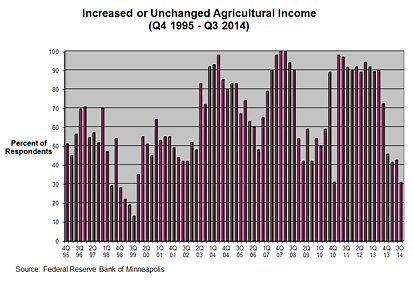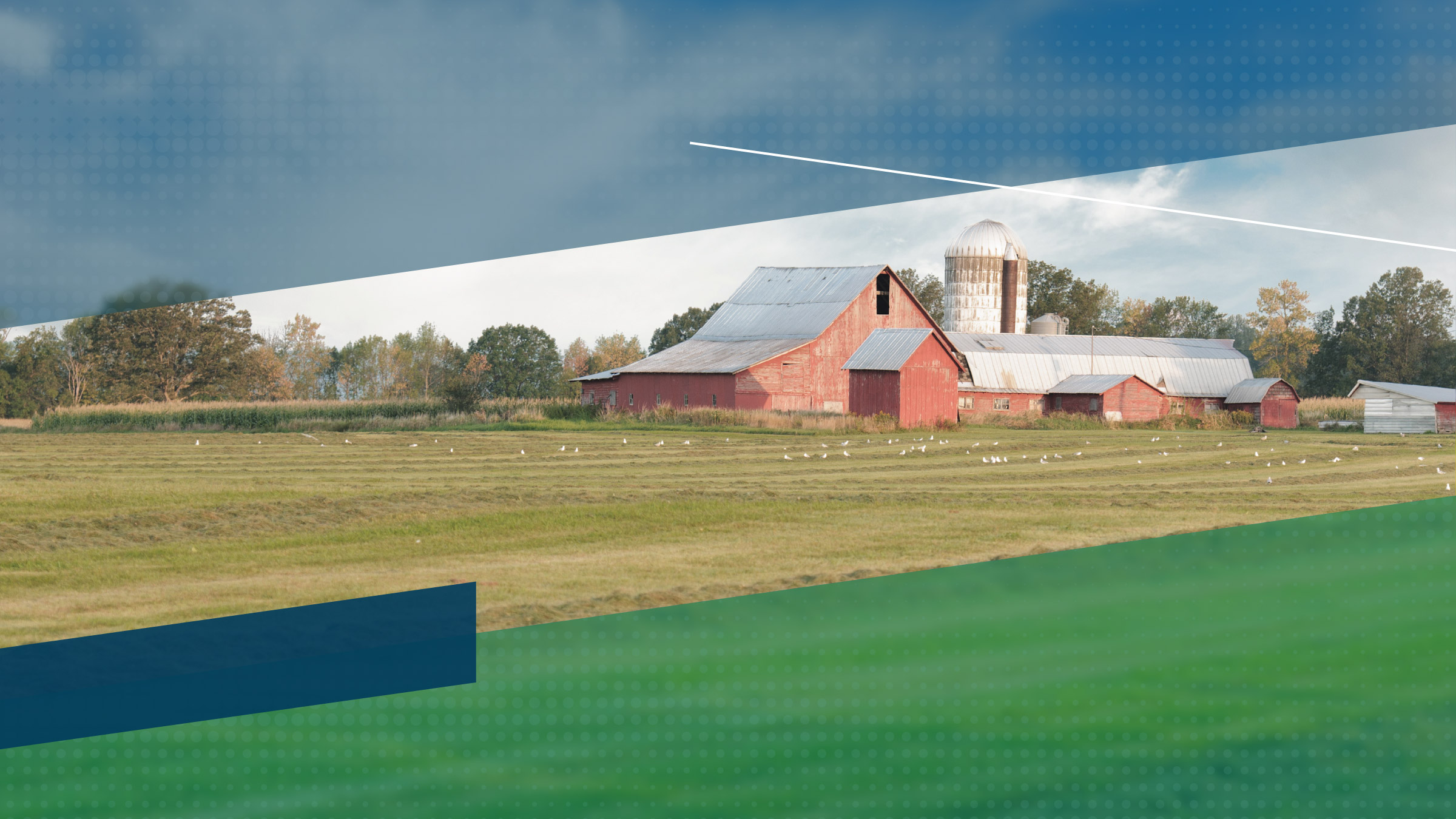Despite a late start on planting, harvests of corn and soybeans this fall were strong, hitting records in some Ninth District states. But falling crop prices dealt a financial blow to farmers from July through September 2014, according to the Minneapolis Fed’s third-quarter (October) agricultural credit conditions survey. Land values retreated further across district states, and interest rates on loans mostly held steady from the previous quarter. The outlook for the fourth quarter is similar, with lenders in the district expecting farm incomes to decrease on average.
Farm income, household spending and capital investment
“We will have a decent crop this year, but don’t expect yield levels to cover the price declines over the last couple months,” commented a South Dakota ag banker. The story appears to be similar throughout most of the region, based on the survey results.
More than two-thirds of district lenders surveyed (69 percent) reported that farm incomes decreased in the third quarter of 2014 from the previous quarter, while only 9 percent said that incomes increased (see chart). Farms also spent less on building and equipment—63 percent of lenders reported decreased capital spending, and only 5 percent said it increased. Household spending within the district was mostly flat, with nearly 63 percent of lenders reporting no change, while 27 percent percent said it decreased.
However, financial conditions were better for livestock and dairy producers, who benefited from stronger prices for animal products. In cattle-heavy Montana, 29 percent of lenders reported increased farm incomes, the same share that reported falling incomes. In Wisconsin, a quarter of respondents said incomes rose, while half said they fell. “Dairy producers have seen excellent margins in 2014,” noted a Wisconsin lender.
Loan repayments and renewals
Tougher financial conditions were reflected in slipping rates of loan repayments by agricultural producers in the district. Renewals increased slightly. While loan repayment rates were unchanged from a year earlier for 62 percent of respondents, 30 percent reported that repayment rates decreased. A majority of lenders, 73 percent, stated that the number of renewals or extensions has held steady, but 26 percent saw increased renewal activity.
Demand for loans, required collateral and interest rates
Tighter cash also led to increased demand for loans by farm households in the third quarter. A third of lenders reported that loan demand increased compared with a year ago, while 52 percent indicated that loan demand was unchanged. The amount of required collateral remained flat, with 87 percent of respondents reporting no change. Fixed and variable interest rates barely changed for both operating and machinery loans, while real estate loan interest rates increased slightly.
Cash rents and land values
“Our crop farms are seeing elevated levels of concern, which is surfacing in lower expected farmland prices and rents,” a Minnesota lender commented. Following a trend from recent quarterly surveys, land prices and cash rents retreated from historic highs. The average value for nonirrigated cropland in the district fell by almost 5 percent from a year earlier, according to survey respondents. Irrigated land fell slightly more (between 5 percent and 6 percent), while ranch- and pastureland values fell almost 3 percent, despite strong livestock and dairy prices. The district average cash rent for nonirrigated land fell 6 percent from a year ago, slightly more than the decrease in value. Rents for irrigated land decreased 10 percent, while ranchland rents, which saw their first decline in the previous survey, fell by 11 percent.
The land market varied across the district. Values fell most in Minnesota and North Dakota, with lenders reporting that nonirrigated cropland prices dropped 9 percent in each state compared with a year earlier. Rents for the same land fell 13 percent in Minnesota, but dropped only 2 percent in North Dakota. The change in North Dakota was noteworthy as the state had seen some of the strongest growth in land values and rents, even during recent quarters when prices had begun to decline elsewhere. Declines in cash rents were seen more broadly in the region, the primary exception being in South Dakota, where nonirrigated cropland rents rose 8 percent as values increased 4 percent.
Outlook
Expectations for the fourth quarter of 2014 are generally downbeat. Across the district, 81 percent of lenders predicted that farm income will decrease, compared with 4 percent forecasting increases. Expectations for household spending are slightly better, with 49 percent expecting decreases, while 77 percent expect capital spending to fall. More than half of respondents expect loan demand to increase in the final three months of 2014, while 48 percent expect loan repayment rates to decline and 44 percent forecast increased renewals and extensions. The amount of required collateral on loans is largely expected to remain unchanged.
Percent of respondents who reported decreased levels for the past three months compared with the same period last year:
| MN |
MT |
ND |
SD |
WI |
Ninth District |
|
| Rate of loan repayments | 40 |
14 |
26 |
28 |
12 |
30 |
| Net farm income | 74 |
29 |
63 |
84 |
50 |
69 |
| Farm household spending | 34 |
14 |
5 |
32 |
50 |
27 |
| Farm capital spending | 79 |
- |
55 |
68 |
50 |
63 |
| Loan demand | 26 |
14 |
5 |
8 |
12 |
15 |
Percent of respondents who reported increased levels for the past three months compared with the same period last year:
| MN |
MT |
ND |
SD |
WI |
Ninth District |
|
| Loan renewals or extensions | 40 |
- |
28 |
16 |
12 |
26 |
| Referrals to other lenders | 6 |
- |
- |
5 |
- |
3 |
| Amount of collateral required | 18 |
- |
5 |
20 |
- |
13 |
| Loan demand | 40 |
14 |
16 |
48 |
12 |
33 |
Note: The Upper Peninsula of Michigan is not part of the survey.
Percent of respondents who expect decreased levels for the next three months:
| MN |
MT |
ND |
SD |
WI |
Ninth District |
|
|---|---|---|---|---|---|---|
| Rate of loan repayments | 53 |
- |
58 |
48 |
50 |
48 |
| Net farm income | 88 |
29 |
80 |
83 |
88 |
81 |
| Farm household spending | 63 |
29 |
35 |
38 |
75 |
49 |
| Farm capital spending | 85 |
29 |
85 |
79 |
63 |
77 |
| Loan demand | 13 |
14 |
11 |
14 |
- |
11 |
Percent of respondents who expect increased levels for the next three months:
| MN |
MT |
ND |
SD |
WI |
Ninth District |
|
|---|---|---|---|---|---|---|
| Loan renewals or extensions | 63 |
14 |
42 |
33 |
25 |
44 |
| Referrals to other lenders | 23 |
- |
6 |
11 |
- |
12 |
| Amount of collateral required | 24 |
- |
11 |
14 |
- |
15 |
| Loan demand | 66 |
14 |
47 |
62 |
25 |
53 |
Note: The Upper Peninsula of Michigan is not part of the survey.
Appendix:
Joe Mahon is a Minneapolis Fed regional outreach director. Joe’s primary responsibilities involve tracking several sectors of the Ninth District economy, including agriculture, manufacturing, energy, and mining.






